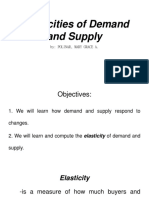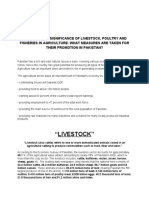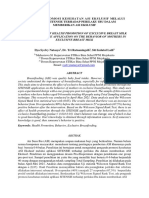Price Elasticitiy of Demand
Price Elasticitiy of Demand
Uploaded by
sara24391Copyright:
Available Formats
Price Elasticitiy of Demand
Price Elasticitiy of Demand
Uploaded by
sara24391Copyright
Available Formats
Share this document
Did you find this document useful?
Is this content inappropriate?
Copyright:
Available Formats
Price Elasticitiy of Demand
Price Elasticitiy of Demand
Uploaded by
sara24391Copyright:
Available Formats
ASSIGNMENT QUESTION:
“DISCUSS THE CONCEPT OF “PRICE ELASTICITY OF DEMAND”. EXPLAIN WITH THE HELP OF
GRAPHS.”
ELASTICITY:
The ratio of percentage change in “one variable” to the percentage change in “another
variable” is called elasticity.
PRICE ELASTICITY OF DEMAND:
It is a type of “demand elasticity”. Price elasticity of demand is defined as
“The percentage change in quantity demanded (Qd) divide by the percentage change in price”
It is represented by a symbol “Ed”. The formula for calculating Ed is
Ed = % Change in Quantity Demanded
% Change in Price Level
OR
Ed = ∆Q × 100 / ∆P × 100
Q P
OR Ed = ∆Q × P
∆P Q
So, price elasticity of demand is measure of the extent to which the quantity demanded of good
changes when the price of the good changes, ceteris paribus. In Business, we want to know the
relationship between Qd and Price. We know if we raise price, then Qd will decline, but we don’t
know how much. Elasticity answers the “how much” part of
the question.
The slope of PED is always negative because of negative slope
of demand. The price and Quantity demanded will always
change in opposite directions. While in calculation we ignore
the negative sign and interpret Ed as a positive value.
INTERPRETATION OF PRICE ELASTICITY OF DEMAND:
Price elasticity of demand may be interpreted depending on its value. The possible 5 cases are
as follows:
If Ed = 1 , Unit elasticity
If Ed = 0 , Perfectly inelastic
If Ed = ∞, Perfectly elastic
If Ed > 1 then Demand is Price Elastic (Demand is sensitive to price changes)
If Ed < 1 then Demand is Price Inelastic (Demand is not sensitive to price changes)
These cases have been separately explained below
“Ed = 1”
“If change in price causes an equal change in demand
for the product then the price elasticity of demand is
known as unit elasticity and so Ed = 1”
In such a case,
Percentage change in demand = Percentage change in price
“Ed = 0”
If quantity demanded does not change at all when price changes,
then demand is perfectly inelastic. In such a case, the value of price
elasticity of demand is zero i.e. Ed = 0
A perfectly inelastic demand is perpendicular to X-axis and it has
zero elasticity.
“Ed = ∞”
At such a point the price decreases no more and demand increases
infinitely and so does price elasticity of demand. Ed is said to be
perfectly elastic.
A perfectly elastic demand is perpendicular to Y-axis and it has
infinite elasticity.
“Ed > 1”
When Ed is greater than 1 then demand elasticity is more
elastic and percentage change in quantity demanded is
greater than percentage change in price.
“Ed < 1”
When Ed is less than 1 then demand elasticity is less
elastic and percentage change in quantity demanded is less than percentage change in price.
SIGNIFICANCE OF PRICE ELASTICITY OF DEMAND:
Profit maximization requires that business set a price that will maximize the firm’s profit
Elasticity tells the firm how much control it has over using price to raise profit
If Ep > 1, then the % Change in Qd > % Change is Price and demand is said to be elastic
o An increase in price will reduce total revenue
o A decrease in price will increase total revenue
If Ep < 1, then the % change in Qd < % change in price, and demand is said to be inelastic
o An increase in price will increase total revenue
o A decrease in price will decrease total revenue
If Ep = 1, then the % change in Qd = % change in Price, and demand is said to be unit
elastic
o An increase in price will have no impact on total revenue
o A decrease in price will have no impact on total revenue
DETERMINANTS OF Ep:
A number of factors can thus affect the elasticity of demand for a good:
Availability of substitute goods
Proportion of income spent on good
Necessity
Duration
Brand loyalty
FACTORS WHICH MAKE Ep ELASTIC:
There are many substitutes.
Substitutes are readily available.
The good is a luxury- something you can do without.
The good is important in terms of proportion of income spent of the goods.
Consumer has plenty of time to search for substitutes.
FACTORS WHICH MAKE Ep INELASTIC:
There are a few substitutes.
Substitutes are difficult to obtain.
The good is a necessity- something you cannot do without.
The good is unimportant in terms of proportion of income spent of the goods.
Little time to search for substitutes.
You might also like
- Musculoskeletal Imaging, The Essentials - Chew (2019)Document1,309 pagesMusculoskeletal Imaging, The Essentials - Chew (2019)Cheyenne RahimiNo ratings yet
- Economics for CFA 2024: level 1 in just one week: CFA level 1, #4From EverandEconomics for CFA 2024: level 1 in just one week: CFA level 1, #4Rating: 4.5 out of 5 stars4.5/5 (2)
- Questionnaire: Impact of Internet Usage On Student's PerformanceDocument1 pageQuestionnaire: Impact of Internet Usage On Student's Performancesara24391No ratings yet
- HRM at NESTLEDocument17 pagesHRM at NESTLEsara24391100% (1)
- Selection ProcessDocument3 pagesSelection Processsara24391No ratings yet
- Bills of ExchangeDocument5 pagesBills of Exchangesara24391100% (7)
- Askari Bank Limited - Swot and Pestel AnalysisDocument17 pagesAskari Bank Limited - Swot and Pestel Analysissara2439189% (28)
- Teaching The Law School CurriculumDocument438 pagesTeaching The Law School CurriculumAakanksha KumarNo ratings yet
- Elasticity of Demand: Price, Income and Cross ElasticityDocument59 pagesElasticity of Demand: Price, Income and Cross Elasticitynithinsp92No ratings yet
- The Elasticity of DemandDocument53 pagesThe Elasticity of DemandShekhar SinghNo ratings yet
- Lecture 03 - Elasticity of Demand and SupplyDocument60 pagesLecture 03 - Elasticity of Demand and SupplyTanveer Khan100% (2)
- Elasticity - DemandDocument31 pagesElasticity - Demandnavin aslam jumaniNo ratings yet
- Elasticity of Demand-1Document15 pagesElasticity of Demand-1sunny mantriNo ratings yet
- Price Elasticity of DemandDocument4 pagesPrice Elasticity of DemandMADmanTalksNo ratings yet
- Unit-II ELASTICITY OF DEMAND (ALL)Document20 pagesUnit-II ELASTICITY OF DEMAND (ALL)stevesilasrockersNo ratings yet
- Eco 5Document31 pagesEco 5Ramish AsifNo ratings yet
- Elasticity of DemandDocument62 pagesElasticity of DemandVikku Agarwal100% (1)
- CH 20 ElasticityDocument28 pagesCH 20 ElasticityEshrat Tarabi Shimla 2211281030No ratings yet
- EA Elasticity of DemandDocument69 pagesEA Elasticity of Demands.muntaha iqbalNo ratings yet
- 3 B Elasticity of DemandDocument30 pages3 B Elasticity of Demandanaita.dattaNo ratings yet
- Econs Unit 2 Chap 8-9-11Document72 pagesEcons Unit 2 Chap 8-9-11b972xmny46No ratings yet
- ElasticityDocument58 pagesElasticityAryan AggarwalNo ratings yet
- Types of Elasticity of Demand Price Elasticity of DemandDocument19 pagesTypes of Elasticity of Demand Price Elasticity of Demandanisul1985No ratings yet
- Price Elasticity of DemandDocument14 pagesPrice Elasticity of DemandSergioNo ratings yet
- Naveena SamaDocument19 pagesNaveena SamaSägñîk KàtårïNo ratings yet
- Elasticity of Demand and SupplyDocument27 pagesElasticity of Demand and SupplyMuskan FatimaNo ratings yet
- ElasticityDocument29 pagesElasticityParul KumarNo ratings yet
- Price Elasticity: Demand Measures The Responsiveness of The Quantity Demanded To A Given Price ChangeDocument5 pagesPrice Elasticity: Demand Measures The Responsiveness of The Quantity Demanded To A Given Price ChangePrerna GillNo ratings yet
- Price Elasticity of Demand (Autosaved) - 1Document5 pagesPrice Elasticity of Demand (Autosaved) - 1Raphinos VakachaNo ratings yet
- Notions of Elasticity: Prepared byDocument26 pagesNotions of Elasticity: Prepared byAndrea SiladanNo ratings yet
- Elasticity of Demand (E) Elasticity Measures The Extent To Which Demand Will ChangeDocument17 pagesElasticity of Demand (E) Elasticity Measures The Extent To Which Demand Will ChangeHimanshu PaliwalNo ratings yet
- Price Elasticity of Demand (PED or E: Economics Percent ChangeDocument3 pagesPrice Elasticity of Demand (PED or E: Economics Percent ChangemustafakarimNo ratings yet
- Various Methods of Price Elasticity of DemandDocument9 pagesVarious Methods of Price Elasticity of Demandsalim132150% (2)
- Price Elasticity of DemandDocument5 pagesPrice Elasticity of DemandManoj KNo ratings yet
- DemandDocument1 pageDemandMuhammad ZubairNo ratings yet
- ElasticityDocument69 pagesElasticityAmit TyagiNo ratings yet
- 2.3-Elasticities and Tax IncidenceDocument49 pages2.3-Elasticities and Tax IncidenceJane WangNo ratings yet
- Module3 Elasticity ConceptsDocument27 pagesModule3 Elasticity ConceptsJASMIN RHYZEL C. PINEDANo ratings yet
- Elasticity of DemandDocument38 pagesElasticity of Demandhitesh sharmaNo ratings yet
- Elasticity Cheat SheetDocument4 pagesElasticity Cheat SheetPratyush SarkarNo ratings yet
- Elasticity of DemandDocument28 pagesElasticity of Demandshweta3547No ratings yet
- Unit 3 MEDocument21 pagesUnit 3 MEshadabrafiNo ratings yet
- ECO201 Spring - 2011 Idea Solution Price Elasticity of DemandDocument3 pagesECO201 Spring - 2011 Idea Solution Price Elasticity of Demandrahay_tashfeenNo ratings yet
- Elasticity and Its Types SLIDESDocument16 pagesElasticity and Its Types SLIDESzahra naheedNo ratings yet
- Micro Economics Assignment: Submitted To Mr. Raj KumarDocument12 pagesMicro Economics Assignment: Submitted To Mr. Raj Kumarpriyaleo_19894819No ratings yet
- Microecons L4Document34 pagesMicroecons L4Zanette LimNo ratings yet
- Elasticity of Demand and Its TypesDocument8 pagesElasticity of Demand and Its TypesCandy DollNo ratings yet
- Meaning of Elasciticity of DemandDocument9 pagesMeaning of Elasciticity of DemandDonasco Casinoo ChrisNo ratings yet
- Group 8 Report DEMANDDocument22 pagesGroup 8 Report DEMANDMa'am Roma GualbertoNo ratings yet
- Economics CT2Document192 pagesEconomics CT2EE19B1004 ADENA VISHNU VARDHAN REDDYNo ratings yet
- UntitledDocument40 pagesUntitledThaddeus TungNo ratings yet
- Santosh Bhandari Assignment1Document18 pagesSantosh Bhandari Assignment1Santosh BhandariNo ratings yet
- Elasticity of DemandDocument29 pagesElasticity of Demandcyril george100% (1)
- Elasticity-Of-Demand 8552087 PowerpointDocument21 pagesElasticity-Of-Demand 8552087 PowerpointChandan NNo ratings yet
- Elasticity of DemandDocument20 pagesElasticity of DemandManvendra Shahi100% (1)
- Eco 101 ElasticityDocument26 pagesEco 101 ElasticityMovie SeriesNo ratings yet
- Chap 3Document19 pagesChap 3Annie DuolingoNo ratings yet
- Fe PBL PDFDocument16 pagesFe PBL PDFsharmabano2004No ratings yet
- ElasticityDocument33 pagesElasticityShiva PaddamNo ratings yet
- Eco Chap 4 PPTDocument17 pagesEco Chap 4 PPTayushpatelap07No ratings yet
- Elasticity of DemandDocument38 pagesElasticity of DemandimadNo ratings yet
- Price Elasticity of DemandDocument4 pagesPrice Elasticity of Demandm7mdasus4060No ratings yet
- Elasticity of DemandDocument16 pagesElasticity of DemandUmamaheswari Rajan100% (1)
- Elasticities of Demand and SupplyDocument18 pagesElasticities of Demand and SupplyGrace AvilaNo ratings yet
- CH 4 ElasticityDocument31 pagesCH 4 Elasticityshaheduzaman ShahedNo ratings yet
- 0 B4 XEs VVG 6 Sfse DNJVN Jza FNF Y015 D GZo RM RRa GC 0 SJK 4 Uk ZRDocument27 pages0 B4 XEs VVG 6 Sfse DNJVN Jza FNF Y015 D GZo RM RRa GC 0 SJK 4 Uk ZRLutfi MaulanaNo ratings yet
- Introduction To Economics 4Document7 pagesIntroduction To Economics 4Wasiq AlamNo ratings yet
- NestleDocument60 pagesNestlesara24391No ratings yet
- 2nd Quarter Accounts 2010 11Document26 pages2nd Quarter Accounts 2010 11sara24391No ratings yet
- Gitmanjoeh 238702 Im05Document25 pagesGitmanjoeh 238702 Im05sara24391No ratings yet
- Tourism in PakistanDocument22 pagesTourism in Pakistansara24391No ratings yet
- Management Information System: Group Members Aqsa Asmat Sara Naeem Hira TahirDocument27 pagesManagement Information System: Group Members Aqsa Asmat Sara Naeem Hira Tahirsara24391No ratings yet
- Porters Five Forces ModelDocument5 pagesPorters Five Forces Modelsara2439167% (3)
- Askari Bank Limited Internship ReportDocument163 pagesAskari Bank Limited Internship Reportsara24391No ratings yet
- Askari Bank LTD - Management Information SystemDocument18 pagesAskari Bank LTD - Management Information Systemsara24391No ratings yet
- Company Registration DocumentsDocument54 pagesCompany Registration Documentssara24391No ratings yet
- Supply Chain ManagementDocument34 pagesSupply Chain Managementsara24391No ratings yet
- Supply Chain ManagementDocument34 pagesSupply Chain Managementsara24391No ratings yet
- Drug AbuseDocument2 pagesDrug Abusesara24391No ratings yet
- National Bank of PakistanDocument27 pagesNational Bank of Pakistansara243910% (1)
- Health and NutritionDocument13 pagesHealth and Nutritionsara24391No ratings yet
- Sme in PakistanDocument26 pagesSme in Pakistansara24391No ratings yet
- Social Class, Their Determinants, Patterns of Social Class in PakistanDocument5 pagesSocial Class, Their Determinants, Patterns of Social Class in Pakistansara2439183% (6)
- Modes of Banking in PakistanDocument12 pagesModes of Banking in Pakistansara24391No ratings yet
- Health and NutritionDocument14 pagesHealth and Nutritionsara24391No ratings yet
- Define Inflation. Explain Various Causes For Inflation in Pakistan (A) Demand Side (B) Supply SideDocument10 pagesDefine Inflation. Explain Various Causes For Inflation in Pakistan (A) Demand Side (B) Supply Sidesara24391No ratings yet
- "Smeda": Highlight The Performance of "Smeda" in Pakistan Over The Last 10 YeasrsDocument15 pages"Smeda": Highlight The Performance of "Smeda" in Pakistan Over The Last 10 Yeasrssara24391No ratings yet
- Sara Naeem 345 Bba-Iii Mrs. Talat Shahid: Submitted ToDocument15 pagesSara Naeem 345 Bba-Iii Mrs. Talat Shahid: Submitted Tosara24391No ratings yet
- LivestockDocument10 pagesLivestocksara24391No ratings yet
- Gerona Catholic School Inc.: Century Literature From The Philippines and The World. Makati, CityDocument15 pagesGerona Catholic School Inc.: Century Literature From The Philippines and The World. Makati, CityJomark RebolledoNo ratings yet
- Sap Business One For: Textile IndustryDocument2 pagesSap Business One For: Textile IndustryMANOJNo ratings yet
- Manuskrip 201701142Document13 pagesManuskrip 201701142Ivan Bastanta SitepuNo ratings yet
- Defense Mechanisms HandoutDocument1 pageDefense Mechanisms HandoutV_FreemanNo ratings yet
- Qcourt: I/Epublic of Tbe .Fjbilippine!IDocument10 pagesQcourt: I/Epublic of Tbe .Fjbilippine!IElizabeth Jade D. CalaorNo ratings yet
- Course Title PEC 103 Subject Descriptions CMO No. 75, S. 2017Document17 pagesCourse Title PEC 103 Subject Descriptions CMO No. 75, S. 2017Rainiel Victor M. CrisologoNo ratings yet
- Doing Cross-Cultural PragmaticDocument10 pagesDoing Cross-Cultural PragmaticlmartinezcondNo ratings yet
- Carbonate Reservoirs Sedimentology & CharacteristicsDocument46 pagesCarbonate Reservoirs Sedimentology & CharacteristicsAbyanNo ratings yet
- Electronic Circuits and Analysis-I Lab ECE 217 Credits:2Document49 pagesElectronic Circuits and Analysis-I Lab ECE 217 Credits:2vj86No ratings yet
- Navguide: Aids To Navigation ManualDocument224 pagesNavguide: Aids To Navigation ManualLu Cinco Afe100% (4)
- Lee vs. Lee Air Framing LTD 1961Document9 pagesLee vs. Lee Air Framing LTD 1961Rajat Kaushik100% (1)
- TalbotPunjab Week3Document15 pagesTalbotPunjab Week3Tatheer ZahraNo ratings yet
- 10th English EC Loyala Guide Sample Notes English Medium PDF DownloadDocument49 pages10th English EC Loyala Guide Sample Notes English Medium PDF Downloadkarthips20001No ratings yet
- T""'L TH Celebrate ... : R V""intDocument4 pagesT""'L TH Celebrate ... : R V""intTrần LuânNo ratings yet
- WK 15 Slide HandoutDocument9 pagesWK 15 Slide HandoutlyramaemanahanNo ratings yet
- Community Participation in Development ProjectsDocument52 pagesCommunity Participation in Development ProjectsRuby GarciaNo ratings yet
- Module 2Document19 pagesModule 2Radhika PremalathaNo ratings yet
- Ballard 1992Document6 pagesBallard 1992hafiz10041976No ratings yet
- 100 Item Exam On Fundamentals of NursingDocument54 pages100 Item Exam On Fundamentals of NursingYen Valien Cugay100% (1)
- New York City's Specialized High Schools: Not The Only Game in TownDocument16 pagesNew York City's Specialized High Schools: Not The Only Game in TownManhattan InstituteNo ratings yet
- PD 8010-2 Presentation April 2005 NewDocument40 pagesPD 8010-2 Presentation April 2005 NewrahulranjanNo ratings yet
- IMU CharacterizationDocument8 pagesIMU CharacterizationWill BlackNo ratings yet
- History 8 Revision WorksheetDocument22 pagesHistory 8 Revision WorksheetTahaa QureshiNo ratings yet
- Top 10 Supplements To Build Mass - Poliquin GroupDocument5 pagesTop 10 Supplements To Build Mass - Poliquin GroupqbrooksNo ratings yet
- Isd77 Nwea Leadership Presentation 2 23 17Document18 pagesIsd77 Nwea Leadership Presentation 2 23 17api-317351136No ratings yet
- The Hindu Literary ReviewDocument3 pagesThe Hindu Literary Reviewamitabha dev choudhuryNo ratings yet
- 0.4 AbrevieriDocument1 page0.4 AbrevieriClaudiu Marius CiobotaruNo ratings yet
- R26 CFA Level 3Document12 pagesR26 CFA Level 3Ashna0188No ratings yet



















































































































